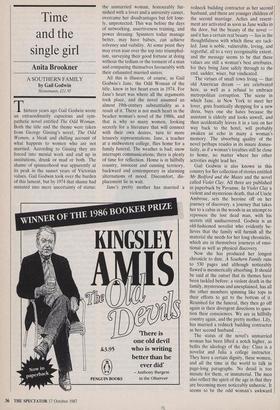Time and the single girl
Anita Brookner
A SOUTHERN FAMILY by Gail Godwin
Heinemann, 171.95
T-. hirteen years ago Gail Godwin wrote an extraordinarily capacious and sym- pathetic novel entitled The Odd Woman. Both the title and the theme were taken from George Gissing's novel, The Odd Women, a bleak and chilling account of what happens to women who are not married. According to Gissing they are forced into menial work and end up in institutions, drunk or mad or both. The shame of spinsterhood was apparently at its peak in the sunset years of Victorian values. Gail Godwin took over the burden of this lament, but by 1974 that shame had mutated into mere uncertainty of status: the unmarried woman, honourably fur- nished with a lover and a university career, overcame her disadvantages but felt lone- ly, unprotected. This was before the days of networking, assertiveness training, and power dressing. Spinsters today manage better, may have babies, can achieve solvency and viability. At some point they may even soar over the top into triumphal- ism, surveying their good fortune at doing without the tedium or the torment of a man and comparing themselves favourably with their exhausted married sisters.
All this is illusion, of course, as Gail Godwin's Jane, the Odd Woman of the title, knew in her heart even in 1974. For Jane's heart was where all the arguments took place, and the novel assumed an almost 19th-century substantiality as a result of it. There is not much heart in the beadier woman's novel of the 1980s, and that is why so many women, looking secretly for a literature that will connect with their own desires, turn to more leisurely representations. Jane, a teacher at a midwestern college, flies home for a family funeral. The weather is bad; snow interrupts communications; there is plenty of time for reflection. Home is in hillbilly country, innocent and cunning territory, backward and contemporary in alarming alternations of mood. Discomfort, dis- placement lie in wait.
Jane's pretty mother has married a redneck building contractor as her second husband, and there are younger children of the second marriage. Aches and resent- ment are activated as soon as Jane walks in the door, but the beauty of the novel — and it has a certain real beauty — lies in the thoughtfulness with which these are tack- led. Jane is noble, vulnerable, loving, and regretful, all to a very recognisable extent, and the message seems to be that these values are still a woman's best attributes, for they bring Jane safely through to the end, sadder, wiser, but vindicated.
The virtues of small town living — that old American dream — are celebrated here, as well as a refusal to embrace metropolitan corruption. The scene in which Jane, in New York to meet her lover, goes frantically shopping for a new dress, buys one she hates because the assistant is elderly and looks unwell, and then accidentally leaves it in a taxi on her way back to the hotel, will probably awaken an echo in many a woman's memory. The absorbing quality of the novel perhaps resides in its innate domes- ticity, as if a woman's loyalties still lie close to home, no matter where her other activities might lead her.
Gail Godwin is also known in this country for lier collection of stories entitled Mr Bedford and the Muses and the novel called Violet Clay. All three are published in paperback by Pavanne. In Violet Clay a violent and mysterious death, that of Uncle Ambrose, sets the heroine off on her journey of discovery, a journey that takes her to a cabin in the woods in an attempt to repossess the lost dead man, with his secrets still undiscovered. Godwin is an old-fashioned novelist who evidently be- lieves that the family will furnish all the material she needs for her long chronicles, which are in themselves journeys of emo- tional as well as physical discovery.
Now she has produced her longest chronicle to date. A Southern Family runs to 530 pages and although noticeably flawed is mesmerically absorbing. It should be said at the outset that its themes have been tackled before: a violent death in the family, mysterious and unexplained, has all the other members spinning like tops in their efforts to get to the bottom of it. Reunited for the funeral, they then go off again in their divergent directions to ques- tion their consciences. We are in hillbilly country again, and the pretty mother, Lily, has married a redneck building contractor as her second husband . . .
The status of the novel's unmarried woman has been lifted a notch higher, as befits the ideology of the day: Clare is a novelist and Julia a college instructor. They have a certain dignity, these women, and all the time in the world to talk in page-long paragraphs. No detail is too minute for them, or immaterial. The men also reflect the spirit of the age in that they are becoming more noticeably unheroic. It seems to be the odd woman's awkward privilege to point this out, at least so Lily, Julia and Clare would appear to tell us. Lily, the wife, is seen to have deteriorated with marriage. Clare, living in concubin- age, is torn with anxiety. Only Julia, celibate, but with a face-saving George in the background, is her own woman.
I enjoyed it. It had the reassuring solid- ity of a novel by Mrs Gaskell for me as I ploughed through its thickening and repeti- tive preoccupations. It is not smart: that is its virtue. It is probably, no, almost cer- tainly, not as good as The Odd Woman. But is seems likely that it will speak to women who still have a desire to be Old-fashioned, and who like a fiction that reflects their major concerns. Not only odd women need apply, even though for once they come out on top.



























































 Previous page
Previous page